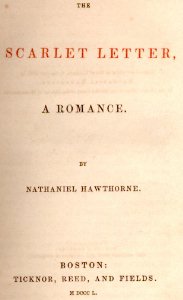Great American Novel
Great American Novel is a concept that refers to a novel that is thought to capture the essence of the American experience. This term is often used to discuss a work of literature that is emblematic of the identity, history, and culture of the United States. The Great American Novel is not a specific book, but rather a symbolic idea that has evolved over time, reflecting the changing dynamics and diverse narratives within American society.
Origins and Definition[edit | edit source]
The term "Great American Novel" was first coined by John William De Forest in an essay published in 1868. De Forest posited that the Great American Novel should depict the American experience in a manner that is both comprehensive and profound. Since its inception, the concept has been the subject of debate among literary critics, authors, and the public, with various novels being proposed as fitting this lofty designation.
Characteristics[edit | edit source]
While there is no consensus on what exactly constitutes the Great American Novel, certain characteristics are often cited as indicative of this status. These include:
- A wide scope, encompassing a broad spectrum of American life and culture.
- Deep exploration of American themes, such as democracy, freedom, the American Dream, individualism, and social mobility.
- Richly drawn characters who represent diverse aspects of American society.
- A narrative that reflects significant historical or social changes in the United States.
Notable Contenders[edit | edit source]
Over the years, several novels have been suggested as embodying the qualities of the Great American Novel. Some of these include:
- Moby-Dick by Herman Melville, which explores themes of obsession, the limits of knowledge, and the American spirit.
- The Adventures of Huckleberry Finn by Mark Twain, considered by many as a strong contender due to its critical examination of race and identity in America.
- The Great Gatsby by F. Scott Fitzgerald, which critiques the American Dream through the lens of the Jazz Age.
- To Kill a Mockingbird by Harper Lee, highlighting racial injustice and moral growth in the American South.
- Invisible Man by Ralph Ellison, addressing the African American experience and issues of identity and social invisibility.
Contemporary Perspectives[edit | edit source]
In recent years, the concept of the Great American Novel has been expanded to include works that represent the increasing diversity of the American experience. Novels by authors from varied backgrounds, addressing themes of immigration, gender, and sexuality, have been proposed as new contenders for this symbolic title.
Criticism[edit | edit source]
The idea of the Great American Novel has faced criticism for various reasons. Some argue that it is an outdated concept that reinforces a monolithic view of American culture. Others believe that the quest for a single, defining work overlooks the richness and diversity of American literature.
Conclusion[edit | edit source]
The Great American Novel remains a compelling idea, symbolizing the quest for a literary work that encapsulates the American spirit. While it may be an elusive goal, the debate and discussion it inspires contribute to an ongoing exploration of American identity through literature.
This article is a literature-related stub. You can help WikiMD by expanding it!
Transform your life with W8MD's budget GLP1 injections from $125
W8MD offers a medical weight loss program NYC and a clinic to lose weight in Philadelphia. Our W8MD's physician supervised medical weight loss centers in NYC provides expert medical guidance, and offers telemedicine options for convenience.
Why choose W8MD?
- Comprehensive care with FDA-approved weight loss medications including:
- loss injections in NYC both generic and brand names:
- weight loss medications including Phentermine, Qsymia, Diethylpropion etc.
- Accept most insurances for visits or discounted self pay cost.
- Generic weight loss injections starting from just $125.00 for the starting dose
- In person weight loss NYC and telemedicine medical weight loss options in New York city available
- Budget GLP1 weight loss injections in NYC starting from $125.00 biweekly with insurance!
Book Your Appointment
Start your NYC weight loss journey today at our NYC medical weight loss, and Philadelphia medical weight loss Call (718)946-5500 for NY and 215 676 2334 for PA
Search WikiMD
Ad.Tired of being Overweight? Try W8MD's NYC physician weight loss.
Semaglutide (Ozempic / Wegovy and Tirzepatide (Mounjaro / Zepbound) available. Call 718 946 5500.
Advertise on WikiMD
|
WikiMD's Wellness Encyclopedia |
| Let Food Be Thy Medicine Medicine Thy Food - Hippocrates |
Translate this page: - East Asian
中文,
日本,
한국어,
South Asian
हिन्दी,
தமிழ்,
తెలుగు,
Urdu,
ಕನ್ನಡ,
Southeast Asian
Indonesian,
Vietnamese,
Thai,
မြန်မာဘာသာ,
বাংলা
European
español,
Deutsch,
français,
Greek,
português do Brasil,
polski,
română,
русский,
Nederlands,
norsk,
svenska,
suomi,
Italian
Middle Eastern & African
عربى,
Turkish,
Persian,
Hebrew,
Afrikaans,
isiZulu,
Kiswahili,
Other
Bulgarian,
Hungarian,
Czech,
Swedish,
മലയാളം,
मराठी,
ਪੰਜਾਬੀ,
ગુજરાતી,
Portuguese,
Ukrainian
Medical Disclaimer: WikiMD is not a substitute for professional medical advice. The information on WikiMD is provided as an information resource only, may be incorrect, outdated or misleading, and is not to be used or relied on for any diagnostic or treatment purposes. Please consult your health care provider before making any healthcare decisions or for guidance about a specific medical condition. WikiMD expressly disclaims responsibility, and shall have no liability, for any damages, loss, injury, or liability whatsoever suffered as a result of your reliance on the information contained in this site. By visiting this site you agree to the foregoing terms and conditions, which may from time to time be changed or supplemented by WikiMD. If you do not agree to the foregoing terms and conditions, you should not enter or use this site. See full disclaimer.
Credits:Most images are courtesy of Wikimedia commons, and templates, categories Wikipedia, licensed under CC BY SA or similar.
Contributors: Prab R. Tumpati, MD







